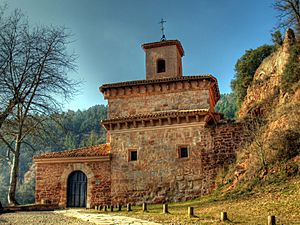Lope Íñiguez facts for kids

Lope Íñiguez (born around 1050, died 1093) became the second Lord of Biscay in 1076. He took over this important role from his father, Íñigo López.
Lope's father, Íñigo, passed away not long after Sancho IV of Navarre, their ruler, died. After Sancho's death, Alfonso VI of Castile took control of several areas, including Biscay, Álava, parts of Guipúzcoa, and La Rioja. Lope accepted Alfonso as his new king. However, the important territory of Nájera in La Rioja, which Lope's father had managed, was given to García Ordóñez. Even so, King Alfonso chose Lope and Diego Álvarez de Oca to promise to protect the special laws, called a fuero, that he had given to Nájera in 1076.
Lope's Growing Power
Because Lope lost control of Nájera, King Alfonso gave him other territories. Lope gained control of Álava in 1081 and Guipúzcoa in 1082. This made him the first leader to bring these three Basque provinces (Biscay, Álava, and Guipúzcoa) under one ruler.
We know about his rule over all three areas from a special document he signed in 1082. This document was a gift he made to the San Millán monastery. He signed it as "I, lord Lope Íñiguez, governing Biscay, Guipúzcoa and Álava." Because Lope had so much power, the church in Álava became part of the Diocese of Calahorra in 1087. In 1089, King Alfonso gave Lope the title of count. This was a very high rank in the kingdom. Lope's influence kept growing. In 1091, he convinced King Alfonso VI to give the San Andrés de Astigarribia monastery to San Millán. This monastery was located right on the border between Biscay and Guipúzcoa.
Lope in Battle
Lope often joined King Alfonso VI in the Reconquista. This was a long period when Christian kingdoms in Spain fought to take back land from Muslim rule. Lope likely helped in the capture of Toledo in 1085. Soldiers from Álava, probably led by Lope, fought in the Battle of Sagrajas in 1086. In the spring of 1092, Lope probably worked with García Ordóñez to protect the Rioja region. They defended it from attacks by Rodrigo Díaz de Vivar, a famous warrior who was living in exile.
Lope's Family
Lope married Ticlo (also known as Tecla) Díaz. She was the daughter of a man named Diego Álvarez, possibly Diego Álvarez de Oca. They got married before 1079. That year, they made a gift together to the San Millán monastery. Ticlo might have brought parts of Las Encartaciones into Lope's control, which then became a permanent part of Biscay.
Lope and Ticlo had an heir, their son Diego I. He was named after Ticlo's father. The names Diego and Lope would be used by the family's leaders for many generations. Ticlo also gave birth to four other children: Sancho, Toda, Sancha, and Teresa. Toda married Lope González de Álava, who later took over Lope's role in Álava. Teresa married García Sánchez de Zurbano and later went on a religious journey to Rome.
After Lope died in 1093, Ticlo gave the Albóniga monastery to San Millán. She did this to honor Lope's memory. Ticlo passed away around 1104 and was buried in San Millán. It is also possible that Lope was the father of Pedro López de Monforte.
| Preceded by Íñigo López |
Lord of Biscay 1076–1093 |
Succeeded by Diego López I de Haro |
See also
 In Spanish: Lope Íñiguez para niños
In Spanish: Lope Íñiguez para niños

